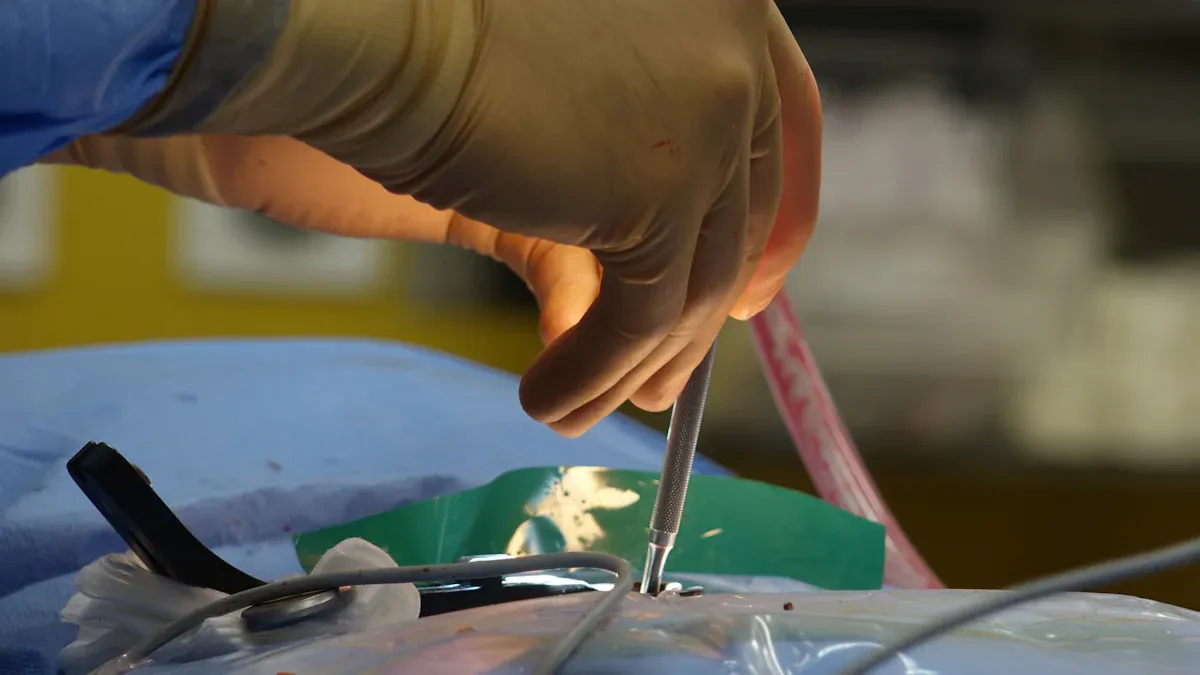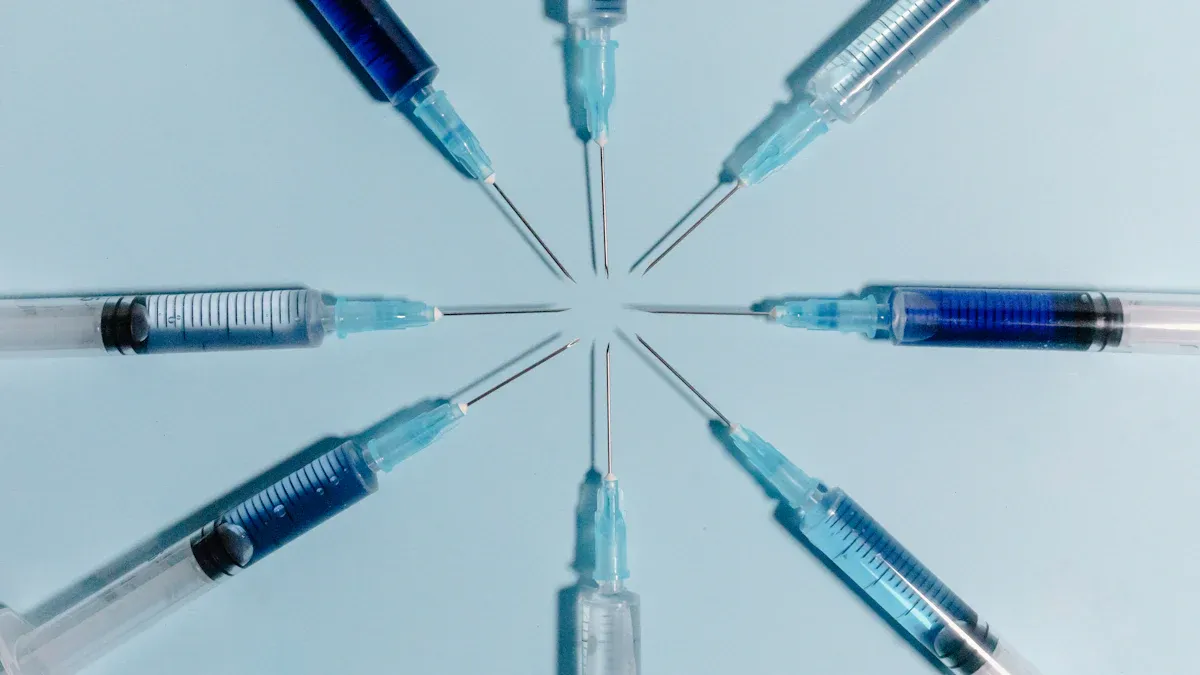What Makes PTFE the Ideal Choice for Medical Catheters

PTFE offers exceptional properties that make it indispensable in medical applications. Its biocompatibility ensures compatibility with the human body, reducing adverse reactions. The low friction of PTFE allows catheters to navigate smoothly through delicate tissues, minimizing discomfort. Its chemical resistance prevents degradation when exposed to bodily fluids or sterilization processes. These qualities make PTFE used in medical catheter manufacturing a reliable choice. By enhancing durability and patient safety, PTFE contributes to better outcomes in healthcare. Its role in advancing catheter technology highlights its importance in modern medicine.
Key Takeaways
PTFE is safe for the body and lowers bad reactions.
Its slippery surface helps catheters move easily, making it more comfortable.
PTFE resists chemicals, so it stays strong in medical settings.
It handles high heat well, which is important for cleaning.
PTFE catheters are strong and last long, needing fewer replacements.
PTFE Used in Medical Catheter Applications

What Is PTFE?
Polytetrafluoroethylene, commonly known as PTFE, is a synthetic fluoropolymer composed entirely of carbon and fluorine atoms. It was first discovered accidentally by DuPont in 1938. Unlike most saturated carbon chains, PTFE has a unique helical structure that contributes to its exceptional properties. These include chemical inertness, low friction, and thermal stability. PTFE is widely recognized for its ability to resist corrosion and maintain its integrity under extreme conditions. Its versatility allows it to be used in various forms, such as coatings, films, and tubing, making it a cornerstone material in medical devices.
Why PTFE Is Essential for Catheters
PTFE's unique characteristics make it indispensable in catheter manufacturing. Its chemical resistance ensures that it does not degrade when exposed to bodily fluids or sterilization processes. The material's low friction allows catheters to glide smoothly through blood vessels and other delicate tissues, reducing the risk of injury and discomfort. PTFE can also be extruded into thin-walled tubing, which is crucial for creating small-diameter catheters that maintain flexibility and functionality. These properties make PTFE used in medical catheter applications a reliable choice for healthcare professionals.
The Role of PTFE in Modern Medical Devices
PTFE plays a vital role in advancing the performance of modern medical devices. Its biocompatibility ensures that it is safe for contact with human tissue, which is essential for implantable devices. PTFE-coated devices, such as catheters and guidewires, benefit from its low friction, enabling smoother insertion and reducing the risk of infections. The material's thermal stability allows it to withstand high-temperature sterilization processes, ensuring hygiene and safety. Additionally, PTFE coatings enhance the durability of medical devices, reducing the likelihood of rejection or inflammation in patients. These attributes highlight PTFE's importance in the development of innovative medical technologies.
Key Properties of PTFE in Catheters
Biocompatibility and Patient Safety
PTFE is highly biocompatible, making it an excellent choice for medical catheters. Its inert nature ensures minimal interaction with human tissues, reducing the risk of adverse reactions. This property is critical for patient safety, especially in long-term catheter use. PTFE's improved biocompatibility also minimizes inflammation and rejection, ensuring a smoother recovery process. Medical professionals rely on PTFE for its ability to maintain compatibility with the human body while delivering reliable performance.
Note: The biocompatibility of PTFE has made it a cornerstone material in modern catheter design, ensuring patient safety and comfort.
Low Friction for Smooth Navigation
PTFE's low coefficient of friction is one of its most remarkable properties. With a coefficient ranging from 0.02 to 0.08, PTFE significantly reduces friction during catheter insertion. This low friction minimizes the "stick-slip" phenomenon, ensuring smooth and consistent navigation through blood vessels and other delicate tissues. The exceptional lubricity of PTFE enhances patient comfort and reduces the risk of tissue damage during procedures.
PTFE surfaces exhibit consistent friction coefficients, often around 0.04, for both static and kinetic friction.
This property ensures seamless movement, even in challenging anatomical pathways.
The unparalleled lubricity of PTFE makes it indispensable in catheter applications, where precision and patient comfort are paramount.
Chemical Resistance and Inertness
PTFE's chemical resistance ensures durability and reliability in medical environments. It remains stable when exposed to a wide range of chemicals, including acids, alcohols, and detergents. Laboratory tests confirm that PTFE does not dissolve or degrade in most organic solvents, such as acetone and benzene. This resistance allows catheters to withstand aggressive sterilization processes without compromising their integrity.
PTFE's inert nature prevents it from reacting with bodily fluids or medications.
Its stability in corrosive media ensures long-term performance in demanding medical applications.
The combination of chemical resistance and inertness makes PTFE a trusted material for catheters, ensuring safety and durability in critical healthcare settings.
Thermal Stability for Versatile Use
PTFE exhibits remarkable thermal stability, making it a reliable material for medical catheters. Its ability to withstand extreme temperatures ensures consistent performance in various medical environments. This property is especially critical for thin-walled catheter liners, which require both durability and flexibility under challenging conditions.
PTFE maintains its structural integrity across a wide temperature range, from -200°C to 260°C. This versatility allows it to perform effectively in both cryogenic and high-temperature applications. Even at temperatures as high as 327°C, PTFE retains its geometric form despite transitioning from a crystalline to an amorphous state. These characteristics make it ideal for medical devices that undergo sterilization or operate in fluctuating thermal conditions.
The following table highlights PTFE's thermal performance metrics:
Property | Value |
|---|---|
Maximum Temperature | Up to 260°C |
Decomposition Temperature | Above 400°C |
Operating Temperature Range | -200°C to 260°C |
Coefficient of Thermal Expansion | 75 to 110 x 10^-6 K^-1 |
Thermal Conductivity | 0.25 to 0.29 W/(m·K) at 23°C |
Specific Heat Capacity | 1.05 to 1.16 J/(g·K) at 23°C |
PTFE's low thermal conductivity further enhances its suitability for medical applications. It provides effective thermal isolation, ensuring patient safety during procedures. Additionally, its specific heat capacity allows it to absorb and dissipate heat efficiently, preventing damage to surrounding tissues.
Thin-walled catheter liners benefit significantly from PTFE's thermal stability. These liners maintain their flexibility and functionality even under extreme conditions, ensuring reliable performance. PTFE's ability to endure high-temperature sterilization processes also ensures hygiene and safety in medical settings.
Tip: PTFE's thermal stability not only enhances the durability of medical catheters but also ensures their compatibility with advanced medical procedures.
Benefits of PTFE Catheters
Enhanced Patient Comfort
PTFE catheters significantly improve patient comfort during medical procedures. The material's low friction ensures smooth insertion and navigation through delicate tissues, minimizing discomfort. This property is especially beneficial in procedures like urinary catheterization, where patient sensitivity is a primary concern. PTFE's super lubricious catheter surfaces reduce the "stick-slip" effect, allowing for seamless movement even in challenging anatomical pathways.
The flexibility of PTFE catheters further enhances comfort by adapting to the body's natural contours. Unlike rigid materials, PTFE maintains its shape without causing unnecessary pressure or irritation. This adaptability makes it an ideal choice for long-term use, ensuring patients experience minimal discomfort throughout their treatment.
Note: The unparalleled lubricity and flexibility of PTFE catheters make them a preferred option for enhancing patient comfort in various medical applications.
Reduced Risk of Infections and Complications
PTFE catheters help reduce the risk of infection and complications by leveraging their biocompatible and inert properties. The material resists adhesion from bacteria and other microorganisms, creating a surface that is less prone to contamination. This feature is critical in urinary catheterization, where the risk of infection is a common concern. By preventing bacterial buildup, PTFE catheters contribute to safer medical outcomes.
Additionally, PTFE's chemical resistance ensures that it remains stable when exposed to bodily fluids and sterilization agents. This stability prevents degradation, which could otherwise lead to complications such as inflammation or tissue damage. Medical professionals rely on PTFE catheters to maintain hygiene and safety, reducing the likelihood of adverse reactions.
PTFE coatings enhance catheter performance by preventing corrosion and maintaining a sterile surface.
The material's inertness ensures compatibility with medications, further reducing the risk of complications.
Durability and Longevity in Use
PTFE catheters are renowned for their enhanced durability and longevity. The material's robust properties allow it to withstand repeated use and sterilization without compromising performance. This durability makes PTFE catheters a cost-effective solution for healthcare providers, as they require less frequent replacement compared to other materials.
Long-term durability tests highlight PTFE's ability to maintain its structural integrity over time. The following table summarizes key benefits of PTFE catheters:
Benefit | Description |
|---|---|
Reduced Friction | PTFE liners provide lower friction, enhancing ease of use in catheters. |
Improved Durability | The material's properties contribute to a longer lifespan of catheters. |
Biocompatibility | PTFE is compatible with body tissues, reducing adverse reactions. |
PTFE catheters also retain their flexibility and functionality under extreme conditions, ensuring reliable performance in demanding medical environments. Their ability to endure high-temperature sterilization processes further enhances their longevity, making them indispensable in modern healthcare.
Tip: The enhanced durability and longevity of PTFE catheters reduce the need for frequent replacements, improving both patient outcomes and healthcare efficiency.
Compatibility with Advanced Medical Procedures
PTFE catheters demonstrate exceptional compatibility with advanced medical procedures due to their unique properties. These catheters provide a smoother glide during insertion and navigation, which is critical for procedures requiring precision. Their low friction reduces resistance, allowing healthcare professionals to perform complex interventions with greater accuracy and efficiency. This feature is particularly valuable in minimally invasive surgeries and interventional radiology.
The durability of PTFE catheters ensures reliable performance in demanding medical environments. They maintain structural integrity over time, even under repeated use and sterilization. This reliability makes them suitable for procedures that require prolonged catheter placement or frequent adjustments. Additionally, their chemically inert nature prevents adverse reactions, ensuring patient safety during extended use.
The following table highlights key performance metrics that make PTFE catheters ideal for advanced medical applications:
Performance Metric | Description |
|---|---|
Reduced Friction | PTFE catheters provide a smoother glide during insertion and navigation, enhancing compatibility with advanced procedures. |
Improved Durability | They maintain structural integrity over time, ensuring reliability in various medical applications. |
Superior Biocompatibility | Their chemically inert nature prevents adverse reactions, making them safe for prolonged use in the human body. |
PTFE's thermal stability further enhances its compatibility with advanced procedures. It withstands high-temperature sterilization processes, ensuring hygiene and safety. This property also allows PTFE catheters to function effectively in environments with fluctuating temperatures, such as cryogenic or heated applications. These attributes make PTFE a trusted material for cutting-edge medical technologies.
The versatility of PTFE catheters supports their use in a wide range of procedures, from cardiovascular interventions to urological treatments. Their ability to adapt to complex anatomical pathways ensures optimal performance, even in challenging scenarios. By combining biocompatibility, durability, and low friction, PTFE catheters continue to play a vital role in advancing modern medical practices.
Innovations in Medical PTFE Coatings and Liners

PTFE Liners for Multi-Layer Catheters
PTFE liners have revolutionized the design of multi-layer catheters by enhancing their performance and durability. These liners, often combined with tie layers, improve adhesion between catheter layers, ensuring structural integrity during use. This innovation reduces the risk of catheter failure under mechanical stress, making them more reliable for medical procedures. PTFE liners also withstand prolonged exposure to bodily fluids without degrading, maintaining their functionality over time.
The flexibility of PTFE liners allows catheters to navigate complex anatomical pathways with ease. This adaptability is critical for minimally invasive surgeries, where precision and smooth movement are essential. Additionally, the low friction of PTFE liners minimizes tissue damage during insertion, enhancing patient comfort. These features make PTFE liners indispensable in modern catheter systems.
PTFE liners with tie layers enhance adhesion and flexibility.
They demonstrate exceptional durability, even under prolonged mechanical stress.
Medical-grade PTFE liners continue to set new standards in catheter technology, ensuring safety and efficiency in healthcare applications.
Advances in PTFE Manufacturing Techniques
Recent advancements in PTFE manufacturing techniques have significantly improved the efficiency and performance of medical devices. Innovations in production processes have enhanced the mechanical properties, durability, and biological resistance of PTFE. These improvements have made medical PTFE coatings more effective in demanding applications, such as catheters and surgical instruments.
The global demand for medical-grade PTFE has grown due to its increasing use in minimally invasive procedures. Companies like Chemours and Zeus Industrial have introduced new PTFE products designed for biocompatibility and sterilization resistance. For example, Chemours launched a PTFE film in 2023 that enhances flexibility and durability in implantable devices. Similarly, Saint-Gobain developed PTFE-coated tubing in 2024, improving ease of insertion for high-performance medical devices.
Company | Innovation Description | Year |
|---|---|---|
Chemours | Launched a new PTFE film for implantable medical devices, enhancing flexibility and durability. | 2023 |
Saint-Gobain | Introduced PTFE-coated tubing for high-performance medical devices, improving ease of insertion. | 2024 |
Zeus Industrial | Released a series of PTFE tubing and coatings designed for biocompatibility and sterilization resistance. | 2024 |
These advancements have also improved manufacturing efficiency, reducing production costs while maintaining high-quality standards. The rise of minimally invasive surgeries and advanced medical treatments continues to drive innovation in PTFE manufacturing, ensuring its relevance in modern healthcare.
The Future of PTFE in Medical Catheters
Emerging Trends in PTFE Applications
The medical-grade PTFE market is expanding rapidly due to its critical role in advanced medical devices. PTFE holds a significant share of 25-30% within the overall PTFE market, driven by its applications in catheters and implants. The increasing demand for minimally invasive surgeries has further accelerated its adoption. These procedures rely on PTFE's unique properties, such as chemical resistance and compatibility with bodily fluids, to ensure safety and efficiency.
The rise of personalized medicine has also contributed to the growing demand for PTFE. Its customizable properties allow manufacturers to create tailored solutions for specific medical needs. For instance, PTFE films are essential for reducing friction in catheters and guidewires, enhancing their performance in complex procedures. Additionally, advancements in manufacturing technologies have improved PTFE's efficiency, making it a preferred choice for medical applications.
The global medical device market, projected to reach USD 690 billion by 2027, highlights the increasing reliance on PTFE. Its ability to perform in harsh environments and its biocompatibility make it indispensable for applications like catheters. As the demand for advanced medical devices grows, PTFE's role in healthcare will continue to expand.
Potential for Further Innovation in Catheter Design
Ongoing research into PTFE-based catheters is unlocking new possibilities in medical technology. Scientists are exploring its use in drug delivery systems and tissue engineering, which could revolutionize patient care. PTFE tubing, already vital in fluid delivery systems, is experiencing rapid growth due to its versatility and reliability.
The demand for minimally invasive procedures has driven the development of PTFE formulations that enhance catheter comfort and effectiveness. Innovations in manufacturing techniques have also contributed to the creation of thinner, more flexible PTFE liners. These advancements improve catheter navigation through complex anatomical pathways, reducing patient discomfort.
The PTFE tubing segment is expected to achieve the fastest growth rate in the coming years. Its essential role in various medical applications, combined with technological advancements, ensures its continued relevance. As researchers develop new materials and techniques, PTFE-based catheters will likely become even more effective and adaptable, meeting the evolving needs of modern medicine.
PTFE remains a cornerstone material for medical catheters due to its unique properties. Its biocompatibility ensures patient safety, while its low friction enhances comfort during procedures. The chemical resistance of PTFE allows catheters to maintain durability even in challenging environments. These qualities improve patient outcomes and reduce risks associated with catheter use.
Ongoing advancements in PTFE manufacturing continue to expand its applications in medical technology. Researchers and manufacturers are exploring innovative ways to enhance catheter performance. This progress ensures that PTFE catheters will remain vital in modern healthcare.
FAQ
What makes PTFE coatings on medical devices so effective?
PTFE coatings on medical devices reduce friction and enhance durability. These coatings ensure smooth navigation through tissues, improving patient comfort. Their chemical resistance prevents degradation during sterilization, making them reliable for various medical applications.
Are PTFE catheters suitable for intravenous procedures?
Yes, PTFE catheters are ideal for intravenous catheters. Their low friction ensures smooth insertion, reducing tissue damage. PTFE's biocompatibility minimizes adverse reactions, making it a trusted material for intravenous use.
How does PTFE improve urinary catheters?
PTFE enhances urinary catheters by providing a smooth, non-stick surface. This reduces bacterial adhesion, lowering the risk of infections. Its flexibility and durability ensure patient comfort and long-term performance.
Can PTFE withstand sterilization processes?
PTFE remains stable during sterilization. Its thermal and chemical resistance ensures that it does not degrade, even under high temperatures or exposure to sterilizing agents. This makes it a reliable choice for sterilized medical devices.
Why is PTFE widely used in medical applications?
PTFE's unique properties, such as biocompatibility, low friction, and chemical resistance, make it indispensable in medical applications. It enhances the performance of devices like catheters, ensuring safety, durability, and patient comfort.

